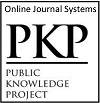IDENTIFYING SALIENT ISSUES IN INFORMATION AND COMMUNICATION TECHNOLOGY EDUCATION IN THE MUSLIM WORLD
Abstract
Keywords
Full Text:
PDFReferences
Chen, A. Y., Mashhadi, A., Ang, D., & Harkrider, N. (1999). Cultural issues in the design of technologyâ€enhanced learning systems. British Journal of Educational Technology, 30(3), 217-230.
Eickelman, D. F. (1999). The coming transformation of the Muslim world. Middle East Review of International Affair, 3(3), 78-81.
Ho, S. S., Lee, W., & Hameed, S. S. (2008). Muslim surfers on the internet: Using the theory of planned behaviour to examine the factors influencing engagement in online religious activities. New Media & Society, 10(1), 93-113. DOI: 10.1177/1461444807085323. Retrieved April 3, 2013 from http://nms.sagepub.com/content/10/1/93.
Huda, M. Q., & Hussin, H. (2010, December). ICT implementation barriers and organizational issues in Islamic-based Higher Education Institution: The case of Syarif Hidayatullah State Islamic University (UIN) Jakarta. In Information and Communication Technology for the Muslim World (ICT4M), 2010 International Conference on (pp. A18-A25). IEEE.
Khalid, F., Nawawi, M., & Roslan, S. (2009). Integration of ICT in Malaysian secondary schools: What conditions will facilitate its use?. The International Journal of Learning, 15(12), 85-94.
Kuriyan, R., Ray, I., & Toyama, K. (2008). Information and communication technologies for development: The bottom of the pyramid model in practice. The Information Society, 24(2), 93-104.
Lau, B. T., & Sim, C. H. (2008). Exploring the extent of ICT adoption among secondary school teachers in Malaysia. International Journal of Computing and ICT Research, 2(2), 19-36.
Lim, C. P., & Pannen, P. (2012). Building the capacity of Indonesian education universities for ICT in pre-service teacher education: A case study of a strategic planning exercise. Australasian Journal of Educational Technology, 28(6), 1061-1067.
Lubis, M. A., Embi, M. A., Yunus, M. M., Wekke, I. S., & Nordin, N. M. (2009). The application of multicultural education and applying ICT on pesantren in South Sulawesi, Indonesia. WSEAS Transactions on Information Science and Applications, 6(8), 1401-1411.
Mandaville, P. (1999). Digital Islam: Changing the boundaries of religious knowledge?. ISIM Newsletter, 2, 1.
Merrow, J. (November 3, 2009). Technology in schools: Problems and possibilities. Retrieved April 20, 2013 from http://takingnote.learningmatters.tv/?p=3261.
Proulx, C. (November 12, 2012). 5 ways technology will impact higher ed in 2013. Retrieved April 16, 2013 from http://www.forbes.com/sites/groupthink/2012/12/11/5-ways-technology-will-impact-higher-ed-in-2013/.
Sassen, S. (2002). Towards a sociology of information technology. Current Sociology, 50(3), 365-388. DOI: 10.1177/0011392102050003005. Retrieved April 3, 2013 from http://csi.sagepub.com/content/50/3/365.
Siddiqui, D. A. (1993). Selected Major Issues in Instructional/Communication Technology: An Islamic Perspective. MUSLIM EDUCATION QUARTERLY, 10, 57-57.
Wicklein, R. C. (2004). Critical issues and problems in technology education. The Technology Teacher, 64(4), 6-9.
DOI: http://dx.doi.org/10.22373/cs.v1i2.2012
Refbacks
- There are currently no refbacks.
Copyright (c) 2017 Ahmad Faizuddin
except where otherwise noted.






















